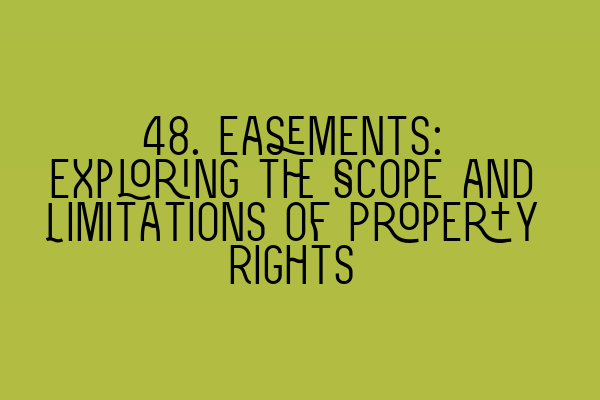48. Easements: Exploring the Scope and Limitations of Property Rights
When it comes to property rights, particularly in relation to land, one concept that often arises is that of easements. Easements play a crucial role in defining the scope and limitations of property rights, and understanding them is essential for property owners, buyers, and developers.
In this article, we will delve into the world of easements and explore their significance in property law. We will discuss what easements are, their various types, their creation and termination, and the limitations they impose on property owners. So, let’s get started!
1. What are Easements?
Easements are the rights enjoyed by one person over another person’s land. They grant the holder of the easement certain rights and privileges, while also imposing restrictions on the landowner. These rights are considered non-possessory, meaning that the holder of the easement does not own the land but has certain limited rights to use it.
Easements can be created for various purposes, such as granting access, allowing the passage of utilities, or preventing obstruction of views. They can significantly impact the use and value of a property, and it is therefore crucial to understand their nature and implications.
2. Types of Easements
There are several types of easements, each with its own unique characteristics and implications. Some common types of easements include:
- Right of Way: This is one of the most common types of easements, allowing a person or group of people to pass through another person’s land. It is often seen in scenarios where a landlocked property needs access to a public road or where a property owner needs to cross someone else’s land to reach their property.
- Utility Easements: These easements allow utility companies, such as gas, water, or electricity providers, to lay pipes, wires, or other infrastructure on someone’s land to provide essential services to the community.
- View Easements: View easements are created to protect the scenic views from a particular property. They typically restrict the landowner from constructing buildings or planting trees that obstruct the view of another property.
- Drainage Easements: These easements grant the right to drain water from one property onto another. They are commonly created to avoid flooding or water accumulation issues.
- Conservation Easements: Conservation easements are designed to preserve the natural or historical features of a property by restricting certain activities or development.
These are just a few examples of the many types of easements that exist. Each type serves a specific purpose and carries specific rights and limitations.
3. Creation and Termination of Easements
Easements can be created in several ways. The most common methods of creating easements include:
- Express Grant: This occurs when the landowner grants an easement to another person through a written document. The document will outline the rights and limitations associated with the easement.
- Implication: Easements can also be created through implication, often based on the previous uses of the land or the intentions of the parties involved.
- Prior Use: If a particular use or access has been in continuous use for a significant period, an easement may be created by presumed dedication.
Easements can also be terminated in several ways, including:
- Mutual Agreement: The landowner and easement holder can agree to terminate the easement through a written agreement.
- Abandonment: If the easement holder stops using the easement for an extended period and shows no intention to reclaim the rights, it may be considered abandoned and terminated.
- Extinction: Easements may also be extinguished if the landowner acquires the rights of the easement holder or if the dominant and servient properties are merged.
4. Limitations Imposed by Easements
Easements, by nature, impose certain limitations on the property owner. These limitations can vary depending on the type and purpose of the easement but generally include:
- Restrictions on the use of the property, such as limitations on construction or development.
- Requirements to maintain and repair the portion of the property subject to the easement.
- Responsibility for costs associated with the easement, such as maintenance or repairs.
- Limitations on the right to exclude others from the easement area.
It is essential for property owners to be aware of these limitations and factor them in when making decisions regarding their property. Additionally, potential buyers should thoroughly assess any existing easements on the property before making a purchase.
Conclusion
Easements are a vital aspect of property law, defining the scope and limitations of property rights. Understanding the various types of easements, their creation and termination methods, and the limitations they impose is crucial for property owners and buyers.
If you have any further questions regarding easements or any other property law matters, feel free to reach out to SQE Property Law & Land Law. We are here to provide expert legal guidance and assistance.
Related Articles:
